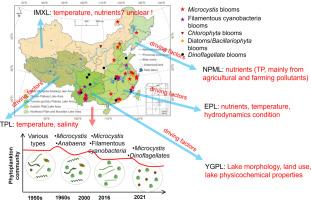Succession of algae population and blooms with their driving factors in China’s lakes
IF 6.3
2区 环境科学与生态学
Q1 ENVIRONMENTAL SCIENCES
引用次数: 0
Abstract
Algae play an important role in lake ecosystems, and algal succession is vital to studying the mechanism of algal bloom outbreaks. This paper provides a comprehensive review of algae blooms development, bloom-forming algae succession, the diversity of common blooms-forming algae, and key drivers for algae succession in Chinese lakes, based on an extensive literature survey and data sets. Furthermore, it summarizes the influencing factors for algae blooms and bloom-forming algae succession in five lake zones of China. The results indicated that the number of research publications on algal blooms in China constituted the largest share of global research, representing 41.9 %. The predominant types of algae blooms in all publications were cyanobacterial blooms, followed by dinoflagellate blooms. The blooms-forming algae in China's lakes have experienced a clear succession pattern: Bacillariophyta, Chlorophyta and Pyrrophyta were dominated in the initial investigations; dominance of Microcystis, Anabaena, dinoflagellates and diatoms increased significantly since1960s; in the past decade, Cylindrospermopsis and dinoflagellates expanded. Current research on algae blooms in Chinese lakes mainly focuses on cyanobacterial blooms, especially Microcystis blooms, while researches on filamentous cyanobacterial blooms and other algae blooms is still insufficient. This systematic review will help researchers to understand the basic features such as the occurrence, the diversity, the physio-ecology and the driving factors of common blooms-forming algae, will further provide a scientific basis for their control in various lake regions.

中国湖泊藻类种群和华度演替及其驱动因素
藻类在湖泊生态系统中扮演着重要的角色,藻类演替是研究藻华爆发机制的关键。本文在大量文献资料的基础上,对中国湖泊藻华的发展、形成华的藻类演替、常见形成华的藻类多样性以及藻类演替的关键驱动因素进行了综述。总结了中国五大湖区藻华和成华藻类演替的影响因素。结果表明,中国关于藻华的研究出版物数量占全球研究的最大份额,占41.9%。在所有出版物中,藻类的主要类型是蓝藻华,其次是鞭毛藻华。中国湖泊成华藻类呈现出明显的演替格局:初期以硅藻、绿藻和绿藻为主;微囊藻、水藻、鞭毛藻和硅藻的优势度显著增加;在过去的十年中,柱生精子和鞭毛类植物得到了扩展。目前对我国湖泊藻华的研究主要集中在蓝藻华,特别是微囊藻华,而对丝状蓝藻华和其他藻华的研究仍然不足。通过系统的综述,将有助于研究人员了解常见成华藻类的发生、多样性、生理生态和驱动因素等基本特征,为各湖区常见成华藻类的防治提供科学依据。
本文章由计算机程序翻译,如有差异,请以英文原文为准。
求助全文
约1分钟内获得全文
求助全文
来源期刊

Journal of Environmental Sciences-china
环境科学-环境科学
CiteScore
13.70
自引率
0.00%
发文量
6354
审稿时长
2.6 months
期刊介绍:
The Journal of Environmental Sciences is an international journal started in 1989. The journal is devoted to publish original, peer-reviewed research papers on main aspects of environmental sciences, such as environmental chemistry, environmental biology, ecology, geosciences and environmental physics. Appropriate subjects include basic and applied research on atmospheric, terrestrial and aquatic environments, pollution control and abatement technology, conservation of natural resources, environmental health and toxicology. Announcements of international environmental science meetings and other recent information are also included.
 求助内容:
求助内容: 应助结果提醒方式:
应助结果提醒方式:


